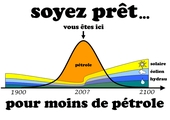Christophe wrote:Yes, that's what I thought I understood ... but in what unit is he speaking?
The heating consumption is linear with the delta of temp int - ext as we have just said ... after there are different yields which come in the "real figures" ...
1) No units. I do like the kings of marketing, I balance figures that mean nothing !!!
2) No, take back the pretty curves that you put and which illustrate well what I was trying to write.
I spoke well for the same comfort setpoint, and of course the same external temperature.
You imagine that we lower even more than what is drawn: the temperature, at the beginning, does not drop any faster. It is the thermal inertia of the house. There is therefore no additional saving. Even without heating, the boiler off, the house "loses" its calories. At the same pace. Whether you program 17 ° or 8 °.
It is only towards the end, just before the rise, that the internal temperature curve would be lower. Instead of pulling asymptotically towards the 17 ° setpoint, it would continue to decrease more (not quite linearly however, since the interior-exterior delta is reduced!). And so there will be some additional savings!
But as it is lower, if you want to be back to 20 ° at the same time (8 hours), you will have to start again a little earlier too.
So in a daily rhythm, lowering more, at a given time, does not bring much more gain, for these two reasons:
- it does not descend faster / no further
- you have to go back earlier ...
My "anything" numbers just wanted to illustrate that.
If you lower it from 20 to 19 °, it will yield "x".
If you lower from 20 to 18 °, it will not be 2X but a little less.
And so on.
And I am not talking about efficiency, lower setpoint, etc ... Nor contributions "other ... I was in a stupid thermal reasoning (but taking into account the inertia of the building)
3) If we wanted savings to be proportional to lowering, we would have to imagine a building
without any inertia :
- at the time of lowering, we "fall" instantly to the "lowered" set temperature (17 ° or 8 ° for example).
- and at the time of the passage in comfort, we would go up instantly.
There, indeed, and there only, the savings, represented by the hollow surface, would be proportional to the reduction.
But it's like dreaming of a car without weight, therefore without inertia, which would instantly accelerate with a moped engine!
4) For long absences, it is obvious that lowering more, to the limit of frost-free, brings additional savings. I wrote it too.




